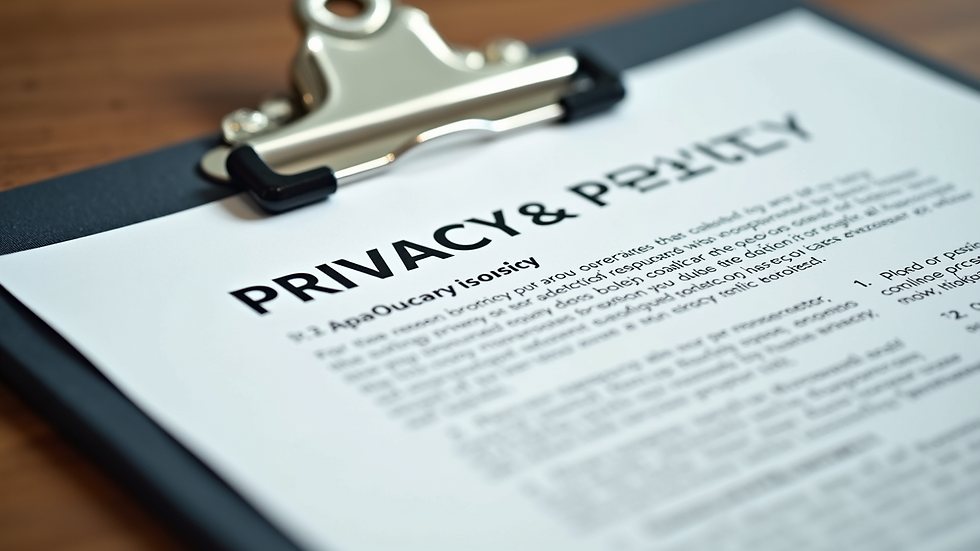Crafting a Privacy Policy: Best Practices for Transparency
- Rich Thompson
.jpg/v1/fill/w_320,h_320/file.jpg)
- 2 hours ago
- 3 min read
Creating a clear and effective privacy policy is crucial for any website or business that collects personal information. A well-crafted privacy policy not only builds trust with users but also ensures compliance with legal requirements. Transparency is key - users want to know exactly how their data is collected, used, and protected. This article will guide you through the best privacy policy guidelines to help you create a transparent and user-friendly document.
Understanding Privacy Policy Guidelines
Privacy policy guidelines serve as a framework to help businesses disclose their data practices clearly and comprehensively. These guidelines ensure that the policy covers all necessary aspects, such as data collection methods, usage, sharing, and user rights.
Key elements to include in your privacy policy:
Types of data collected: Specify whether you collect personal information like names, emails, payment details, or non-personal data such as cookies and IP addresses.
Purpose of data collection: Explain why you collect this data, for example, to improve services, process payments, or send marketing communications.
Data sharing: Clarify if and when you share data with third parties, such as service providers or legal authorities.
User rights: Inform users about their rights, including access, correction, deletion, and opting out of data collection.
Data security: Describe the measures you take to protect user data from unauthorized access or breaches.
Policy updates: State how users will be informed about changes to the privacy policy.
Following these guidelines helps ensure your privacy policy is comprehensive and easy to understand.

Why Transparency Matters in Privacy Policies
Transparency builds trust between your business and your users. When users understand how their data is handled, they are more likely to engage with your services confidently. Lack of transparency can lead to suspicion, loss of customers, and even legal penalties.
Benefits of transparency include:
Improved user trust: Clear communication about data practices reassures users.
Legal compliance: Many regulations, such as GDPR and CCPA, require transparent privacy policies.
Reduced risk of disputes: Users who know their rights and data usage are less likely to file complaints.
Better business reputation: Transparency reflects ethical business practices.
To enhance transparency, use simple language, avoid legal jargon, and organize the policy into clear sections. Consider adding a summary or FAQ section to address common questions.

Can you get a privacy policy for free?
Many businesses and website owners wonder if they can obtain a privacy policy without incurring costs. The answer is yes - there are several free resources and generators available online that can help you create a basic privacy policy.
Options for free privacy policies:
Online privacy policy generators: Websites offer customizable templates where you input your business details and data practices. These are quick and easy but may lack customization.
Open-source templates: Some organizations provide free privacy policy templates that you can download and modify.
Legal aid websites: Certain nonprofit or government sites offer guidance and sample policies for free.
However, free policies may not cover all specific legal requirements or unique business practices. For comprehensive and legally sound privacy policy creation, consider consulting a professional or using paid services tailored to your industry.

Practical Tips for Effective Privacy Policy Creation
When drafting your privacy policy, keep these practical tips in mind to ensure clarity and compliance:
Be concise but thorough: Avoid overly long documents but include all necessary information.
Use plain language: Write in simple terms that your audience can easily understand.
Organize content logically: Use headings, bullet points, and numbered lists for easy navigation.
Update regularly: Review and revise your policy whenever your data practices change.
Link to your policy prominently: Make sure the privacy policy is accessible from every page of your website.
Include contact information: Provide a way for users to reach out with questions or concerns.
Incorporating these tips will help you create a privacy policy that users appreciate and trust.
For those interested in professional assistance, privacy policy creation services can provide tailored solutions that meet your specific needs.
Staying Ahead with Privacy Policy Best Practices
Privacy laws and user expectations are constantly evolving. Staying ahead means regularly monitoring legal developments and adapting your privacy policy accordingly.
Best practices to maintain compliance and transparency:
Monitor regulatory changes: Keep up with updates to laws like GDPR, CCPA, and others relevant to your location.
Conduct privacy audits: Periodically review your data collection and handling processes.
Train your team: Ensure employees understand privacy policies and data protection responsibilities.
Use clear consent mechanisms: Obtain explicit consent where required and document it.
Be proactive with breach notifications: Have a plan to inform users promptly if their data is compromised.
By following these best practices, you demonstrate your commitment to protecting user privacy and maintaining transparency.

Crafting a transparent and effective privacy policy is an ongoing process that requires attention to detail and a commitment to user trust. By following these privacy policy guidelines, you can create a document that not only complies with legal standards but also fosters confidence among your users.




Comments